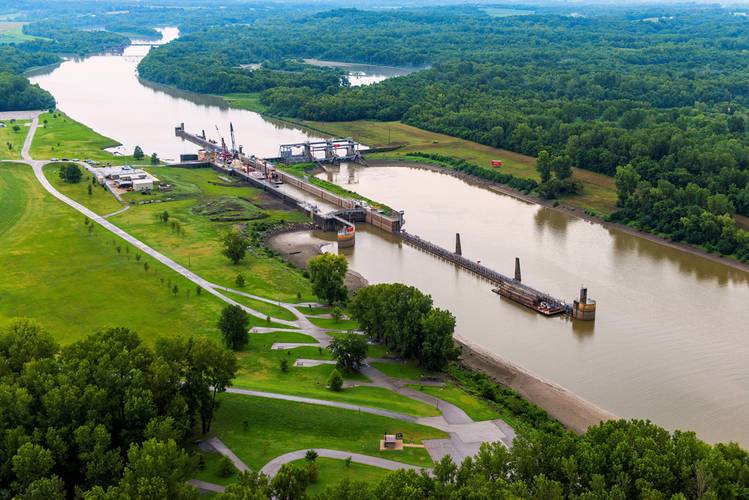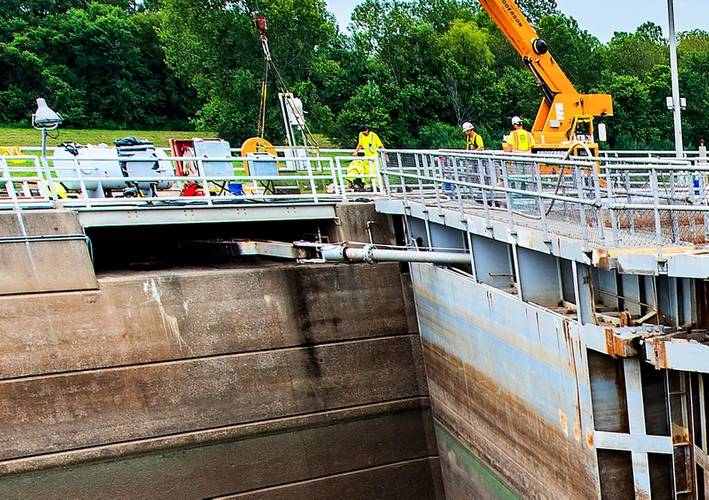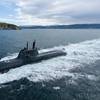Creative Approach Keeps Commerce Flowing Amidst Historic Flooding
Operational changes keep Jerry F. Costello Lock and Dam open for 17 days longer than typical during high water events.
While the record flooding in 2019 disrupted barge traffic throughout the inland waterways in the Midwest for extended periods this spring and summer, a little out-of-the-box thinking helped limit the number of days the Jerry F. Costello Lock and Dam was forced to close, keeping commerce flowing on the Kaskaskia River in Southern Illinois for several additional days during the persistent high water.
The Kaskaskia River is a critical transportation link for several commodities, including scrubber stone and coiled steel inbound, and grain and slag outbound, moving 1.5 million tons per year. The river is navigable due to the Jerry F. Costello Lock and Dam – which is only 8/10 of a mile upstream from the Mississippi River channel and, therefore, greatly influenced by high water conditions on the Mississippi River. The conditions this summer were ripe to have a significant impact on commodity flows on the Kaskaskia River, but the U.S. Army Corps of Engineers demonstrated outstanding flexibility in taking creative measures to help to minimize the impact.
In non-flood years, Jerry F. Costello Lock and Dam has operated up to an elevation of 380.5 feet. Above 380.5 feet, it would be closed, and no barge traffic would be allowed to lock through. This elevation generally equates to 34.0 feet on the Chester, Illinois gauge. As a result, industries had to use backup plans to move their products to market or they had to wait out the flood event, prompting calls from industry to find a way to operate the lock at a higher level. That demand, coupled with the nature of this year’s flooding, led the Army Corps of Engineers to re-evaluate its operations, and it was determined that, with some additional labor and other operational changes, the lock could operate safely at a level of approximately 382.5 feet, ultimately allowing barge traffic to move through the lock at 2.0 feet higher than normal operating conditions.
“Each flood operates a little different – the big difference this time that allowed us to make these changes was a direct result of the longevity of the flood,” said Courtney Wilson, Assistant Manager of the Kaskaskia Navigation Project for the Army Corps of Engineers. “We were able to reassess our high-water operations that allowed the lock to operate 2.0 feet higher, which doesn’t seem like a lot, but in the grand scheme of things is an impressive achievement.”
The new elevation required that the lock stage four employees at strategic locations with fire hoses to be able to flush any debris out of the lock arm cavity to avoid breakage and debris getting clogged in the mechanical lock arms. This manpower modification created a more efficient method to operate the lock that allowed for 11 more operational days at the end of the first flood, shaved one day off the beginning of the second flood and facilitated opening the lock four days earlier at the end of that second flood.
“We applaud the Army Corps of Engineers on trying something out of the ordinary, particularly during a time a crisis, and we consider their actions to be a great triumph for both the Army Corps of Engineers and industry,” said Ed Weilbacher, General Manager of Kaskaskia Regional Port District, which jointly handles operations on the Kaskaskia River via a three-way partnership between the Port, U.S. Army Corps of Engineers and Illinois Department of Natural Resources. “For the Corps of Engineers to think beyond what it normally does to respond to industry needs was phenomenal and much appreciated. It demonstrated that adapting in this way yielded significant benefits for barge industry and helps to make the case for continued manpower modifications during future flooding and, hopefully, paves the way to get to a permanent fix.”
A recent study completed by the Corps of Engineers determined it is feasible to modify the lock arms and operate at 382.96 feet without additional manpower or fire hoses to keep the debris away. A $1.5 million investment would allow a higher operation through future floods, also replacing the 40 plus year old arms with new ones that would last for decades to come. The modified lock arms would be even more effective than the operational changes put in place this year. In all, the Flood of 2019 caused the lock and dam to close for a total of 87 days, while the new operations policy allowed the lock and dam to operate 17 more days than normal. Without the policy change, the closure could have stretched out for more than 100 days. With a permanent change to the lock arms, it is estimated the lock and dam could have been opened an additional four days for a total of 21 days, further minimizing the disruption for shippers.
“The St. Louis region is widely recognized for its world class freight network, and the creative approach to minimizing the disruption from flooding this year further enhances that reputation,” said Mary Lamie, Executive Director of the St. Louis Regional Freightway. “We commend the quick thinking of the Army Corps of Engineers, which in partnership with Kaskaskia Regional Port District, reinforced the benefits of moving commodities on the St. Louis region’s inland waterways.”












